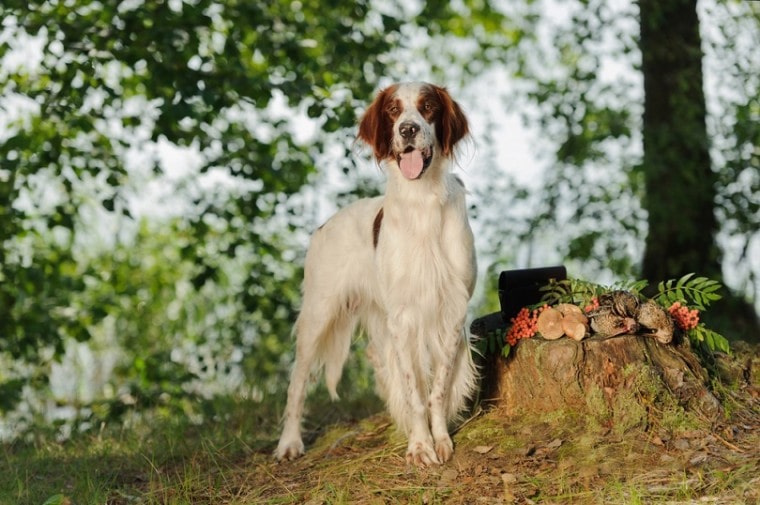
While Ireland may be small compared to some other countries, it has produced several dog breeds. Many of these are strikingly different from each other and range from Terriers to Spaniels to Setters. Some of these dogs are quite common and available all over the world today. Others are incredibly rare and difficult to find outside of small geographical areas. Some may even be hard to find in Ireland!
Here, we look at several of these Irish dog breeds.
Top 9 Irish Dog Breeds:
1. Glen of Imaal Terrier

This adorable dog is one of the four Terriers that originated in Ireland. They are also known as the Wicklow Terrier and by a shortened form of their name, Glen. They originated from the Glen of Imaal, which they were named after.
This Terrier first came into the limelight during the reign of Elizabeth I. She hired many soldiers to help with the rebellion in Ireland. After the war, many soldiers stayed in the Wicklow area of Ireland. Many brought their dogs with them. Due to the general geographic isolation of the dogs, they slowly developed into their own breed.
Originally, these dogs were used for keeping pest animals under control, including foxes, badgers, and otters. Unlike most Terriers, these dogs were not bred to bark. In fact, they are often described as “mute” when they are working. Their job was to silently sneak up on their prey rather than scare it off. Dogs were disqualified from hunting competitions if they barked at the prey, so most were bred to be silent. Today, they are still one of the quietest Terriers around.
This breed is rare today and is considered a vulnerable native breed by the U.K. Kennel Club. They almost died out before they were revived in the 20th century. They are mostly found in their native land today. In the U.S., only a few hundred of these dogs are registered.
2. Irish Red and White Setter

The Irish Red and White Setter is fairly similar to other Irish Setters. However, this dog is more likely to be used as a working gun dog today, which makes them slightly different from other breeds. They’re less likely to develop health problems and are typically more resilient. They are extremely practical animals.
They are used to hunt gamebirds, particularly those that don’t startle or fly to avoid predators. This breed likely came onto the scene early, but they almost went extinct in the 19th century. Today, they are still considered a vulnerable breed, though they have started to make a comeback.
They are well-known for being great family dogs due to their devotion and affectionate behavior. They are quite intelligent and respond quickly to training, which makes them great hunting dogs. They do have high-energy needs, so they work best in active families.
Irish Red and White Setters are prone to a few different disorders. One is canine leucocyte adhesion deficiency, which involves a failure of the immune system. These dogs usually don’t reach their first birthday, as they are incredibly prone to infections. Von Willebrand’s disease is another condition that they are prone to. As a clotting disorder, the blood of dogs affected by this genetic condition cannot clot properly. The dog may bleed out from small wounds.
3. Irish Setter
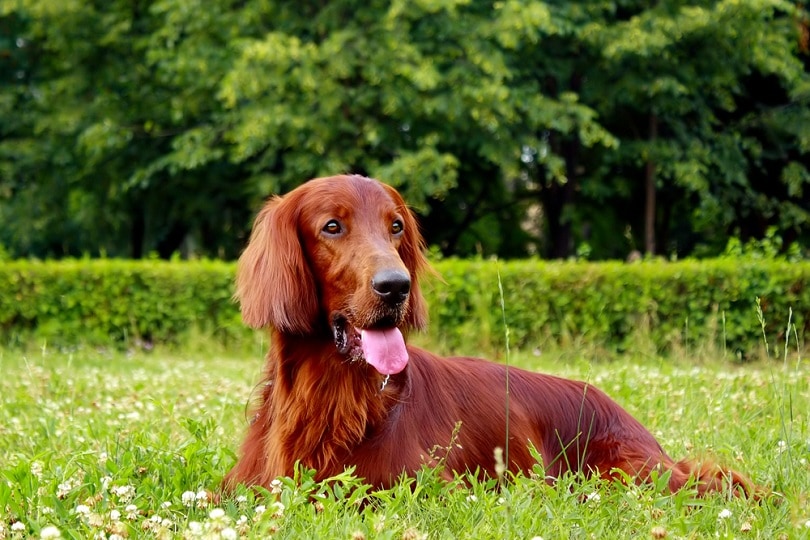
The Irish Setter is one of the more popular dog breeds that originated in Ireland. Originally used as gundogs, these canines are mostly show and family dogs today. They get along well with children and other dogs, often enthusiastically meeting strangers at the door. Many are good with cats as long as they are introduced from a young age. They may be a bit too hyper for small children, though. This breed is characterized by their high level of affection toward their family.
As working dogs, they are quite active. They require plenty of activity and long walks. They enjoy being given a job to do. Lack of activity leads to a bored dog, which often leads to destructive behavior. They are not dogs that can be left alone for long periods of time, as they thrive on human companionship.
They tend to be a relatively healthy breed. They are prone to a few health problems, including hip dysplasia, progressive retinal atrophy, and epilepsy.
4. Irish Terrier

This brown and adorable breed is likely one of the oldest Terriers in the world. They are one of the many breeds of Terrier that originate from Ireland. They are popular throughout Ireland and the U.K. and have been since the 1800s.
They are an active, compact breed that can adapt to nearly any living situation. They can live in the city easily if their exercise needs are met. They are also suitable for rural areas. Their red coat protects them from all sorts of different weather.
As intelligent dogs, they require a great deal of stimulation. They can do well in many dog sports, including canine agility. They aren’t as hyperactive as some other breeds, though. They can easily relax inside a home after they have run around for a bit. That said, they can go from 0 to 100 quite quickly. They are good with people and have a significant sense of loyalty.
This breed is generally healthy and can live for up to 14 years. They do not have any eye or breathing problems, due to careful breeding. Their proportions are not exaggerated like other breeds, which leads to them being healthier than most. They are not prone to food allergies either, and due to their small size, they have a low occurrence of hip dysplasia.
5. Irish Water Spaniel
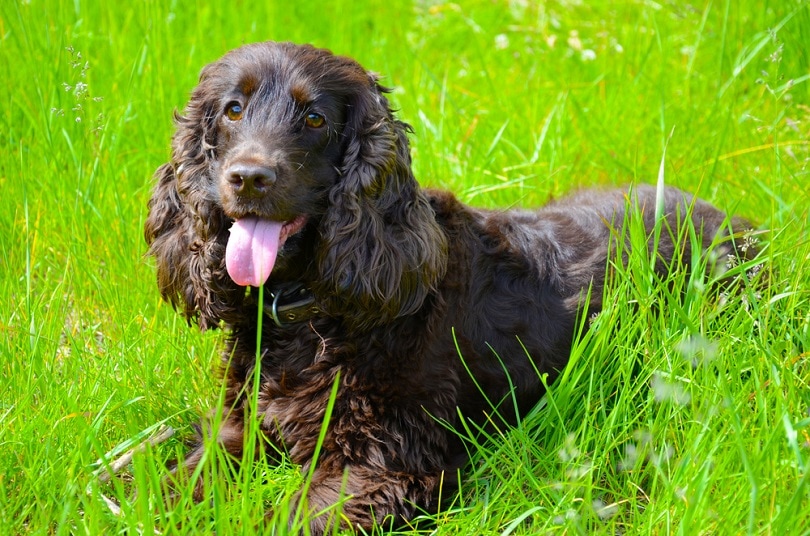
The Irish Water Spaniel is the tallest of the Spaniels. They are a sturdy breed with dense curls. They shed little and have a unique purplish hue that isn’t found in any other breed. While they do look similar to Poodles, their coat requires little to no trimming. They were built for swimming and even have webbed feet.
This is an active and energetic breed. They were originally used to fetch birds, so they often return items without a fuss. They have a natural instinct to please their people and often do well in training for this reason. They are quite intelligent and do require mental stimulation, but this can be accomplished easily through training.
Early socialization is essential for this breed. They can become fearful of strangers and other animals otherwise. They are respectful of children and other pets with the proper socialization. They are not aggressive but their bark can sound ferocious.
Despite how their coat looks, it requires little maintenance. An occasional combing to remove dirt and debris is all that is necessary. Some owners choose to have their Irish Water Spaniels trimmed occasionally, but they do not need extensive trimming like Poodles.
6. Irish Wolfhound
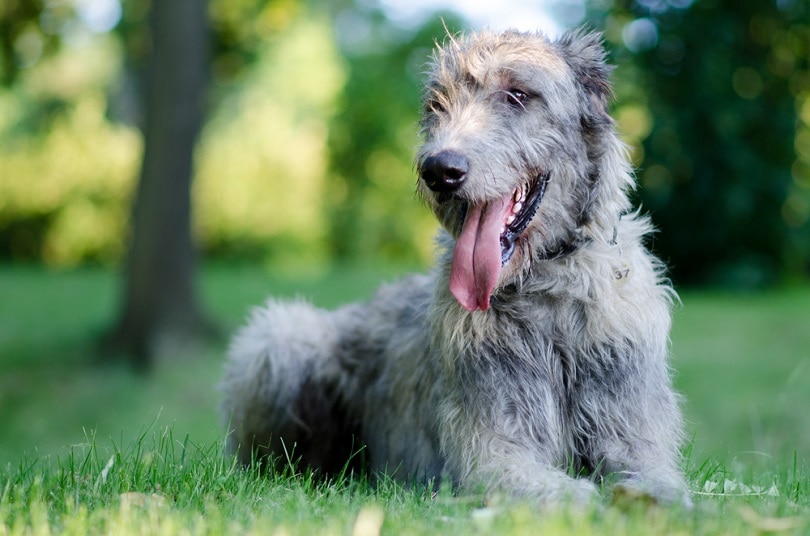
The Irish Wolfhound is probably one of the most well-known dog breeds in the world. They are extremely large dogs that can reach up to 155 pounds. Many of them are as big as some adult humans. They were used historically to hunt wolves and protect homes and livestock from predators. They are also swift sighthounds that can take down large prey.
These canines are well-known for their range of quirks. They have a huge variety of different personalities. It is often hard to know what you’re getting with this dog breed. They are usually well-behaved in the house. Most are introverted and reserved. They aren’t aggressive with strangers but probably won’t go out of their way to make friends with them either. These easygoing animals are often quiet and keep to themselves for the most part.
They are not guard dogs, though they will guard people. They aren’t territorial, so they won’t dislike people coming onto their property. They are independent but will often listen to their owners. They become quite attached to their people, so they aren’t the most adaptable dogs out there. They do not do well with rehoming.
These breeds have a relatively short lifespan, likely due to their large size. They usually live about 7 years on average. Cardiomyopathy and bone cancer are common causes of death. Many of these dogs die of bone cancer before they reach a decade. Neutering puts the dog at a higher risk of bone cancer and is usually not recommended until the dog is at least fully grown.
They are adjustable to suburban and urban life, as they only have a medium activity requirement.
7. Kerry Beagle

The Kerry Beagle is the only scent hound that was developed in Ireland. They share little in common with Beagles, though, which sometimes causes confusion. It is unclear why the term “Beagle” was applied.
They are pack hounds that get along well with just about everyone. They have a strong hunting instinct, so a fenced-in yard is absolutely required to prevent them from getting lost. They require significant levels of exercise and will need multiple walks. Running around is a great way for them to get exercise, though they can’t be trusted off-leash unless they are behind a secure fence. They are prone to going off on scent trails and getting lost.
This breed probably dates back to at least the 16th century. Detailed pedigrees date back as far as 1794, so the breed was well-established at this point. In the 1800s, the breed dwindled in number, but they have since made a resurgence. They were originally used to hunt stags. However, they are used today to take down fox and hare.
8. Kerry Blue Terrier

This Kerry Blue Terrier is a Terrier breed that was developed in Ireland. They were originally bred to keep fields free from rats, badgers, foxes, hares, and similar animals. They have had many different jobs, including herding and guarding. This dog has spread throughout the world as a companion and working dog. However, they are decently uncommon, though not as rare as other Terrier breeds.
This Terrier is highly spirited and active, much like other Terriers. They are affectionate toward their owners and tend to be quite affectionate. They can be good with children but aren’t typically great with other pets. They have kept many of their hunting instincts into modern times, so they will chase small animals.
They are intelligent and fast dogs, though they can be a bit stubborn, like many Terriers. In modern times, many of them are a bit less aggressive than they once were, due to things like strict breeding practices. They are extremely active dogs that require an active family. They aren’t necessarily good dogs for first-time owners.
9. Soft-Coated Wheaten Terrier
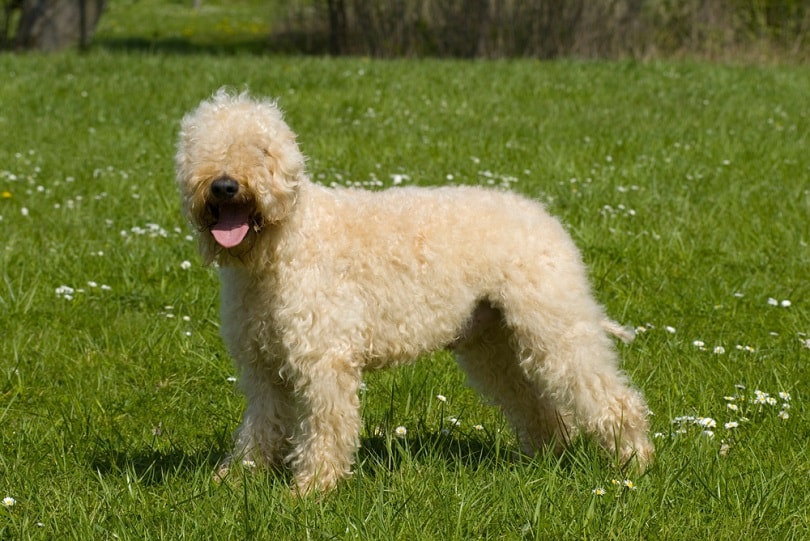
The Soft-Coated Wheaten Terrier originated in Ireland. They have two different coat types: Irish and heavy. The Irish coat is silky and wavy, while the heavy coat is thicker. These dogs are well-known for their playful temperament. They tend to get along with almost everyone, including children and other dogs.
This canine is energetic and playful, like most Terriers. They are intelligent but don’t always obey commands. They weren’t bred to listen to people, and it shows. They love people and tend to jump on visitors due to their excitedness. They have a strong prey drive and will chase things, so they aren’t particularly good for households with cats. They can be protective, though they aren’t aggressive outright.
Featured Image Credit: Glenkar, Shutterstock





